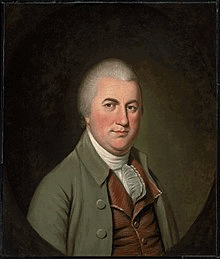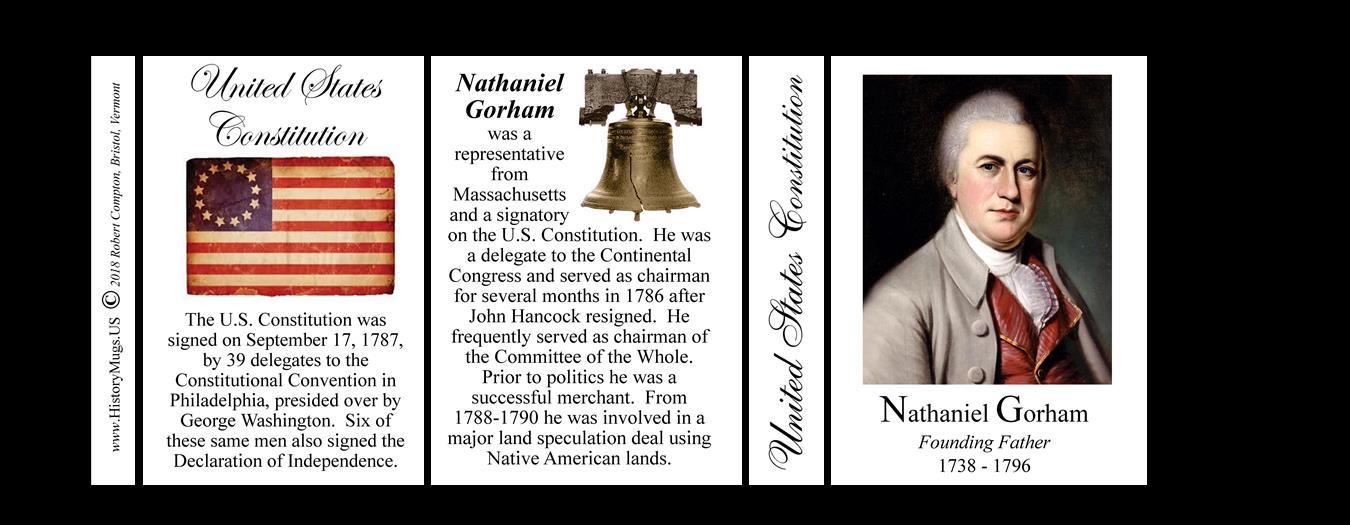History of Nathaniel Gorham
Enjoy Royal Riviera Pears and Gourmet Cheese Gift for $49.99
Nathaniel Gorham
Jump to navigationJump to search
| Personal details | |
|---|---|
| 6th President of the Confederation Congress | |
Nathaniel Gorham | |
 Nathaniel Gorham | |
| In office June 6, 1786 – February 2, 1787[1] | |
| Preceded by | John Hancock |
| Succeeded by | Arthur St. Clair |
| Born | May 27, 1738 Charlestown, Massachusetts |
| Died | June 11, 1796 (aged 58) Charlestown, Massachusetts |
| Resting place | Phipps Street Burying Ground Charlestown |
| Spouse(s) | Rebecca Call |
| Children |
|
| Profession | Politician, merchant |
| Signature | |
Nathaniel Gorham (May 27, 1738 – June 11, 1796), his first name is sometimes spelled Nathanial) was a politician and merchant from Massachusetts. He was a delegate from Massachusetts to the Continental Congress, and for six months served as the presiding officer of that body. He also attended the Constitutional Convention and was one of the signers of the United States Constitution on September 17, 1787, in Philadelphia, Pennsylvania.
Contents
Biography[edit]
Early life and family[edit]
Gorham was born in Charlestown, Boston, Massachusetts, and was the son of Captain Nathaniel Gorham and his father's wife Mary Soley.[2] His 3rd great grandfather was John Howland (c. 1599–1673), who was one of the Pilgrims who traveled from England to North America on the Mayflower, signed the Mayflower Compact, and helped found the Plymouth Colony.[3][4] His sister, Elizabeth Gorham, who married John Leighton, was the ancestor of Edith Kermit Carow Roosevelt, the second wife of Theodore Roosevelt, who served as First Lady of the United States during his presidency from 1901 to 1909.[5]
Marriage[edit]
He married Rebecca Call, who was descended from Anglican vicar and the first minister of Dorchester, Massachusetts, John Maverick, and his royally descended wife, Mary Gye Maverick. Rev. John Maverick was born in Awliscombe, Devon, baptized there on December 28, 1578, and enrolled at Oxford October 24, 1595, age 18. He was the son of Rev. Peter Maverick (spelled Mavericke in old English records), the vicar of Awliscombe. on September 6, 1763, in Charlestown, Massachusetts. She was born on May 14, 1744, in Charlestown, and died there on November 18, 1812. She was the daughter of Caleb Call and Rebecca Stimson.[6] They were the parents of nine children.[2]
Career[edit]
Starting at 15, he served an apprenticeship with a merchant in New London, Connecticut, after which he opened a merchant house in Charlestown, Massachusetts, in 1759.[7] He took part in public affairs at the beginning of the American Revolution: he was a member of the Massachusetts General Court (legislature) from 1771 until 1775, a delegate to the Provincial congress from 1774 until 1775, and a member of the Board of War from 1778 until its dissolution in 1781. In 1779 he served in the state constitutional convention. He was a delegate to the Congress of the Confederation from 1782 until 1783, and also from 1785 until 1787, serving as its president for five months from June 6 to November 5, 1786, after the resignation of John Hancock. Gorham also served a term as judge of the Middlesex County Court of Common Pleas.[8]
In 1786 it might have been Gorham who suggested to Alexander Hamilton that Prince Henry of Prussia would become President[9] or King of the United States. However, the offer was revoked before the prince could make a reply.[10]
For several months in 1787, Gorham served as one of the Massachusetts delegates to the United States Constitutional Convention.[11] Gorham frequently served as Chairman of the Convention's Committee of the Whole, meaning that he (rather than the President of the Convention, George Washington) presided over convention sessions during the delegates' first deliberations on the structure of the new government in late May and June 1787. After the convention, he worked hard to see that the Constitution was approved in his home state. In connection with Oliver Phelps, he purchased from the state of Massachusetts in 1788 pre-emption rights to an immense tract of land in western New York State which straddled the Genesee River, all for the sum of $1,000,000 (about $15.1 million today) (the Phelps and Gorham Purchase).[12][13] The land in question had been previously ceded to Massachusetts from the state of New York under the 1786 Treaty of Hartford. The pre-emption right gave them the first or preemptive right to obtain clear title to this land from the Indians. They soon extinguished the Indian title to the portion of the land east of the Genesee River, as well as a 185,000 acres (750 km2) tract west of the Genesee, the Mill Yard Tract, surveyed all of it, laid out townships, and sold large parts to speculators and settlers. Nathaniel Gorham Jr. (died October 22, 1836, Canandaigua, New York) was a pioneer settler of this tract, having been placed in charge of his father's interests there.[14]
In 1790, after Gorham and Phelps defaulted in payment, they sold nearly all of their unsold lands east of the Genesee to Robert Morris, who eventually resold those lands to The Pulteney Association. Phelps and Gorham were unable to fulfill their contract in full to Massachusetts, so in 1790, they surrendered back to Massachusetts that portion of the lands which remained under the Indian title, namely, the land west of the Genesee. It also was eventually acquired by Robert Morris, who resold most of it to The Holland Land Company. Morris did keep 500,000 acres (2,000 km2) of land that became known as The Morris Reserve.
Death and legacy[edit]
Gorham died in Charlestown, Massachusetts, in 1796. A eulogy was delivered in his memory by Dr. Thomas Welch of Charlestown.[15] He is buried in the Phipps Street Cemetery in Charlestown.[12][16]
Gorham Street in Madison, Wisconsin, is named in his honor.[17] The Town of Gorham, New York, is also named in his honor.[18]
Descendants[edit]
Nathaniel Gorham's descendants number in the thousands today.[19] Some of his notable descendants include:
- Bishop Phillips Brooks was an American clergyman and author, who briefly served as Bishop of Massachusetts in the Episcopal Church during the early 1890s. He is best known for authoring the Christmas carol "O Little Town of Bethlehem".
- Charles Francis Adams Jr. was a member of the prominent Adams family, and son of Charles Francis Adams Sr.. He served as a colonel in the Union Army during the American Civil War and was a railroad executive following the war.
- John Quincy Adams II was an American lawyer and politician, the son of Charles Francis Adams Sr. and the grandson and namesake of president John Quincy Adams.
- Charles Francis Adams III was the United States Secretary of the Navy under President Herbert Hoover and a well-known yachtsman.
- Charles Francis Adams IV was a US electronics industrialist. He served as the first president of the Raytheon Company.
- Nathaniel's son Benjamin Gorham was a US Representative from Massachusetts.
- Brooks Adams was an American historian and a critic of capitalism.
- Henry Adams was an American journalist, historian, academic and novelist. He is best known for his autobiographical book, The Education of Henry Adams.
- William Everett was the son of Charlotte Gray Brooks and orator Edward Everett who spoke at Gettysburg, Pennsylvania
- Octavius Brooks Frothingham was an American clergyman and author.
- Catherine Lovering Adams married Henry Stugis Morgan, who was an American banker. He was the son of John Pierpont ("Jack") Morgan Jr. and the grandson of renowned banker John Pierpont Morgan Sr., founder of J.P. Morgan & Co..
- Catherine Bartlett was the wife of James Walker, who was the President of Harvard College from 1853 to 1860. Walker was also a Unitarian minister and religious philosopher.
- Charlotte Gray Brooks was the wife of Edward Everett, an American politician and educator from Massachusetts. He served as president of Harvard College.
- Peter Bulkeley Greenough was an American journalist and editor. He was the husband of opera singer Beverly Sills.
- Gorham Parks was a U.S. Representative from Maine, and a Democratic Party candidate for Maine Governor.
- Cort William Gorham, member of council in the town of Brielle, New Jersey.


